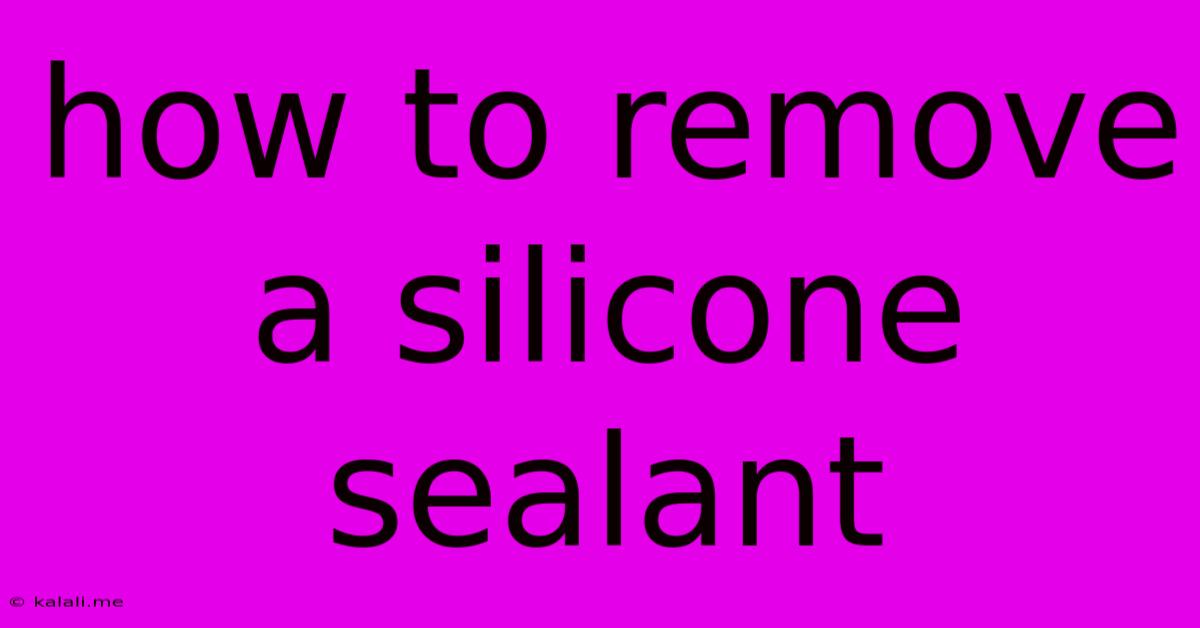How To Remove A Silicone Sealant
Kalali
May 31, 2025 · 4 min read

Table of Contents
How to Remove Silicone Sealant: A Comprehensive Guide
Removing silicone sealant can be a frustrating task, but with the right tools and techniques, it's manageable. This guide provides a comprehensive approach to removing silicone sealant from various surfaces, ensuring a clean and professional finish. This includes tackling tough spots and minimizing damage to the surrounding areas.
Silicone sealant, while durable and water-resistant, is notoriously difficult to remove. Whether you're tackling a DIY project, home renovation, or simply updating your bathroom's caulking, understanding the proper removal techniques is crucial. This article will cover various methods, from simple scraping to chemical solutions, ensuring you achieve the best results.
Understanding Silicone Sealant and its Removal Challenges
Before diving into removal methods, let's understand why silicone sealant is so difficult to remove. Its strong adhesive properties and elasticity make it cling tenaciously to surfaces. Traditional scraping methods often leave behind residue, requiring more aggressive techniques. The type of surface the sealant is applied to also influences the best removal method.
Essential Tools for Silicone Sealant Removal
Gathering the right tools beforehand significantly streamlines the process and minimizes damage. You’ll likely need:
- Utility knife or scraper: For initial cutting and removing larger portions of the sealant. A sharp blade is crucial for clean cuts.
- Putty knife: Ideal for scraping away softened sealant and cleaning crevices. Choose a plastic or rubber putty knife to avoid scratching delicate surfaces.
- Silicone remover: A chemical solvent specifically designed to break down silicone's bonds. Always follow the manufacturer's instructions.
- Safety glasses and gloves: Protect your eyes and skin from chemical irritants and sharp tools.
- Cloth or rags: For cleaning up residue and excess solvent.
- Solvent-resistant container: To safely dispose of used silicone remover.
Step-by-Step Guide to Removing Silicone Sealant
The removal process varies slightly depending on the type of sealant and surface, but the following steps provide a general guideline:
- Prepare the area: Protect surrounding surfaces with masking tape or cloth to prevent accidental damage.
- Cut the sealant: Use a utility knife or scraper to carefully cut away the majority of the silicone sealant. Make several shallow cuts to prevent damaging the underlying surface.
- Apply silicone remover (if necessary): For stubborn sealant, apply a silicone remover according to the manufacturer's instructions. Allow the remover to soak in for the recommended time to weaken the sealant's bond.
- Scrape away softened sealant: Use a plastic or rubber putty knife to carefully scrape away the softened silicone. Work slowly and patiently to avoid damaging the underlying surface.
- Clean the surface: Once the majority of the sealant is removed, clean the area with a damp cloth to remove any remaining residue.
- Final cleanup: Use a suitable cleaning agent (appropriate for the surface) to remove any lingering silicone remover or residue. Allow the area to dry completely before applying new sealant.
Removing Silicone Sealant from Specific Surfaces
The method for removing silicone sealant can vary based on the surface:
- Glass: Glass is relatively easy to clean. The risk of scratching is lower, allowing for more aggressive scraping techniques.
- Metal: Be careful to avoid scratching the metal surface. Use a plastic scraper and apply minimal pressure.
- Wood: Wood is more delicate. Apply silicone remover generously and let it soak in before scraping.
- Ceramic Tile: Ceramic tile is generally durable; however, use caution to avoid scratching the grout.
Preventing Future Silicone Sealant Removal Challenges
Preventing future sealant removal is just as important as the removal process itself. Here are some preventative measures:
- Choose high-quality sealant: Invest in a reputable brand of silicone sealant to ensure long-lasting durability and easy removal if necessary in the future.
- Proper application: Ensure that the surface is clean and dry before applying the sealant. Apply the sealant evenly and smoothly.
- Regular inspection and maintenance: Periodically inspect the sealant for signs of damage or deterioration. Address any issues promptly to prevent major removal projects later.
Removing silicone sealant can be challenging, but with the right tools, patience, and techniques, you can achieve a clean and professional finish. Remember to always prioritize safety and choose the appropriate method for your specific surface and sealant type.
Latest Posts
Latest Posts
-
Max Level For Pokemon In Pokemon Go
Jun 02, 2025
-
80d Shutter Count Utility For Pc
Jun 02, 2025
-
Air Conditioner Not Keeping Up With Thermostat
Jun 02, 2025
-
How To Bypass Google Lock On Motorola After Factory Reset
Jun 02, 2025
-
How To Remove Broken Spark Plug
Jun 02, 2025
Related Post
Thank you for visiting our website which covers about How To Remove A Silicone Sealant . We hope the information provided has been useful to you. Feel free to contact us if you have any questions or need further assistance. See you next time and don't miss to bookmark.